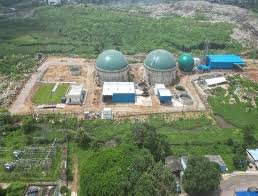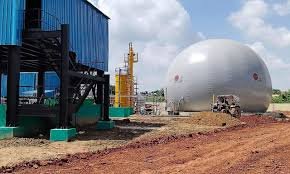GAIL’s First Compressed Biogas (CBG) Plant Inaugurated by PM Modi in Jharkhand
Introduction to the Inauguration
Prime Minister Narendra Modi inaugurated the first Compressed Biogas (CBG) plant by GAIL (India) Limited in Jharkhand on October 2, 2024. This milestone event marks a significant step towards promoting renewable energy in the country. Located in the Ramgarh district, the plant aims to utilize agricultural residue and waste to generate biogas, contributing to sustainable development and energy security.
The Significance of the CBG Plant
The CBG plant in Jharkhand is expected to produce approximately 1.5 tonnes of compressed biogas daily. The gas will be supplied to the national gas grid, thereby reducing dependence on conventional fossil fuels. This initiative is part of India’s broader goal to enhance renewable energy production and meet its commitments under the Paris Agreement.
Benefits of the Project
The project not only aims to produce clean energy but also focuses on addressing the issue of agricultural waste management. By converting waste into energy, the CBG plant will significantly reduce methane emissions, a potent greenhouse gas. Furthermore, the initiative will create job opportunities and boost local economies by promoting green energy initiatives.
PM Modi’s Vision for Renewable Energy
During the inauguration, PM Modi emphasized the importance of transitioning to renewable energy sources to combat climate change. He stated that projects like the CBG plant align with the government’s commitment to achieving 500 GW of non-fossil fuel energy capacity by 2030. The prime minister’s vision reflects a deep understanding of the need for sustainable development in the face of global environmental challenges.
Conclusion
The inauguration of GAIL’s first CBG plant in Jharkhand represents a significant advancement in India’s renewable energy sector. By utilizing agricultural waste and promoting clean energy production, the initiative is set to play a crucial role in the country’s journey towards sustainable development.

Why This News is Important
Transitioning to Renewable Energy
The inauguration of GAIL’s first CBG plant in Jharkhand is a pivotal moment in India’s renewable energy journey. As the nation seeks to reduce its carbon footprint, the establishment of this plant illustrates a commitment to harnessing clean energy sources.
Combating Climate Change
The CBG plant will significantly help in reducing methane emissions by utilizing agricultural waste, which otherwise contributes to greenhouse gas emissions. This aligns with global efforts to combat climate change, making this project not just a national achievement but a part of the global environmental movement.
Promoting Energy Security
By producing biogas and integrating it into the national gas grid, India is taking substantial steps towards energy independence. This reduces reliance on imported fossil fuels, ensuring a more secure and sustainable energy future for the country.
Supporting Local Economies
The CBG plant is expected to create job opportunities in rural areas, contributing to local economies. By investing in green technology, the government aims to boost employment and support livelihoods, especially for farmers.
Aligning with Government Policies
The inauguration of the CBG plant is in line with the government’s initiatives to promote sustainable development and clean energy. This event reinforces the commitment to achieving the targets set in the National Action Plan on Climate Change and the Paris Agreement.
Historical Context
India’s Renewable Energy Landscape
India has made significant strides in renewable energy over the past decade. The country is currently one of the world’s largest producers of renewable energy, with substantial investments in solar, wind, and biomass energy. The government’s commitment to achieving 175 GW of renewable energy capacity by 2022 was a landmark step towards a greener future.
The Role of Compressed Biogas
Compressed Biogas (CBG) has emerged as a viable alternative to conventional fossil fuels. CBG is produced from organic waste and agricultural residues, making it a sustainable energy source. The government has been promoting CBG production through various schemes, recognizing its potential in waste management and renewable energy generation.
GAIL’s Contribution to Renewable Energy
GAIL (India) Limited has been at the forefront of promoting renewable energy in India. The company’s initiatives include setting up CBG plants and investing in natural gas infrastructure. GAIL’s efforts align with the government’s vision for a cleaner and more sustainable energy sector.
Key Takeaways from “PM Modi Inaugurates GAIL’s First CBG Plant in Jharkhand”
| S.No | Key Takeaway |
|---|---|
| 1 | PM Modi inaugurated GAIL’s first Compressed Biogas plant in Jharkhand on October 2, 2024. |
| 2 | The plant aims to produce approximately 1.5 tonnes of biogas daily from agricultural waste. |
| 3 | The initiative supports India’s goal of achieving 500 GW of non-fossil fuel energy capacity by 2030. |
| 4 | The project is expected to significantly reduce methane emissions, promoting environmental sustainability. |
| 5 | The CBG plant will create job opportunities and contribute to local economies through green energy initiatives. |
Important FAQs for Students from this News
1. What is a Compressed Biogas (CBG) plant?
A CBG plant is a facility that converts organic waste, such as agricultural residue, into compressed biogas. This renewable energy source can be used for cooking, heating, and as fuel for vehicles.
2. Why is the CBG plant significant for Jharkhand?
The CBG plant in Jharkhand is significant as it utilizes local agricultural waste to produce renewable energy, contributing to waste management, reducing emissions, and promoting energy security in the region.
3. How much biogas is expected to be produced daily at the plant?
The plant is expected to produce approximately 1.5 tonnes of compressed biogas daily.
4. What are the environmental benefits of the CBG plant?
The plant aims to reduce methane emissions by converting agricultural waste into energy. This contributes to cleaner air and supports global efforts to combat climate change.
5. How does this project align with India’s renewable energy goals?
This initiative aligns with India’s commitment to achieving 500 GW of non-fossil fuel energy capacity by 2030, reflecting the government’s focus on sustainable development and clean energy.
Some Important Current Affairs Links


















 Exciting News!
Exciting News!  Join Our Telegram Channel Now!
Join Our Telegram Channel Now!
 Join our Telegram channel for a thrilling adventure into the world of daily current affairs.
Join our Telegram channel for a thrilling adventure into the world of daily current affairs. 
 Don’t miss out on the latest updates and insights! Click to join now and be part of the knowledge revolution!
Don’t miss out on the latest updates and insights! Click to join now and be part of the knowledge revolution! 
